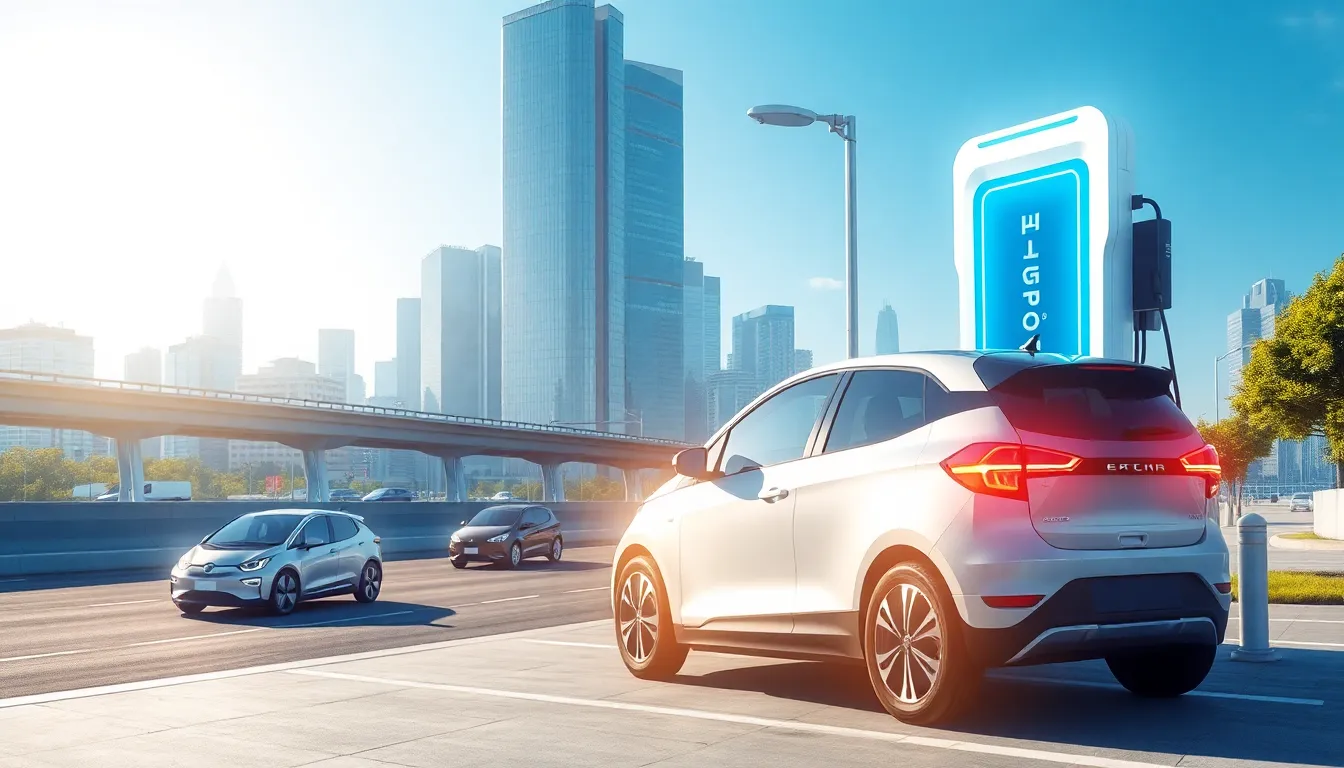In a world where getting stuck in traffic feels like a rite of passage, emerging transportation technologies are here to rescue us from our four-wheeled woes. Imagine zipping through the skies in a flying car or hopping on a hyperloop that makes your morning commute feel like a joyride. These innovations aren’t just pipe dreams; they’re on the fast track to reality, promising to revolutionize the way we travel.
As cities grow and congestion becomes the norm, these advancements are not only exciting but essential. From electric vehicles that whisper rather than roar to autonomous systems that could finally let us catch up on that podcast, the future of transportation is bright—and a little bit hilarious. Buckle up as we explore the tech that’s set to change the way we move, making travel faster, greener, and maybe even a little more fun.
Table of Contents
ToggleOverview Of Emerging Transportation Technologies
Innovative transportation technologies aim to significantly enhance travel experiences and reduce congestion. Electric vehicles represent a critical shift towards sustainable transportation. Their widespread adoption contributes to lower emissions and improved air quality. In addition, autonomous vehicles are transforming mobility by eliminating the need for human drivers. This technology utilizes advanced sensors and artificial intelligence, allowing vehicles to navigate safely and efficiently.
Flying cars, once a dream, now appear poised for reality. Several companies are actively developing vertical takeoff and landing vehicles, designed for urban environments. These vehicles promise to decrease travel time in congested areas. Hyperloops serve as another groundbreaking concept, featuring high-speed pods traveling through low-pressure tubes. By achieving speeds of over 600 miles per hour, hyperloops could revolutionize intercity transport.
Mobility-as-a-Service solutions have emerged, integrating various transportation modes into unified services. Users access public transit, ride-sharing, and bike-sharing through a single platform. Electric scooters and bicycles increasingly populate urban settings, promoting short-distance travel options. Augmented reality is also gaining traction, providing real-time navigation and information to enhance user experiences.
Infrastructural innovations support these technologies. Smart traffic management systems utilize data to optimize traffic flow, reducing delays. Dedicated lanes for autonomous and electric vehicles enable efficient travel, enhancing overall system performance. Investment in charging infrastructure remains essential, fostering electric vehicle adoption further.
These advancements create pathways toward more efficient and eco-friendly transportation systems. As urban landscapes evolve, the integration of these technologies becomes crucial for future mobility solutions.
Key Innovations Shaping The Future

Innovative transportation technologies are rapidly transforming travel. These advancements include electric vehicles, autonomous vehicles, and hyperloop systems, each playing a vital role in shaping future mobility.
Electric Vehicles
Electric vehicles represent a fundamental shift in transportation. They contribute significantly to reducing greenhouse gas emissions, promoting cleaner air quality. Features like regenerative braking improve energy efficiency, making these vehicles more sustainable. Approximately 20% of global vehicle sales are now electric, demonstrating the growing consumer demand. Leading manufacturers are expanding their electric offerings, fostering competition and innovation. Adequate charging infrastructure supports this rise, allowing for seamless integration into daily life.
Autonomous Vehicles
Autonomous vehicles are revolutionizing mobility by utilizing advanced technologies. Artificial intelligence, sensors, and real-time data processing enable safe navigation without human intervention. Companies like Waymo and Tesla are testing these vehicles on public roads, showcasing their potential. Safety improvements are notable, as many studies suggest that autonomous systems could reduce traffic accidents significantly. Additionally, ride-sharing platforms are incorporating autonomous options, making transportation more accessible and efficient. Urban planning is adapting to support these innovations, paving the way for a new era in travel.
Hyperloop Systems
Hyperloop systems promise to redefine intercity travel with unprecedented speed. This technology employs pods traveling through low-pressure tubes, achieving speeds over 600 miles per hour. Initiatives in the U.S. and Europe are already in various phases of development, showing promise for widespread implementation. Potentially, hyperloops could connect major cities in mere minutes, reducing traffic congestion and travel times. Investment from both private and public sectors fuels this ambitious vision, creating opportunities for economic growth. Sustainable energy sources for operations further enhance their ecological benefits.
Impact On Urban Mobility
Emerging transportation technologies significantly influence urban mobility, shaping how people traverse cities. Innovations, including electric vehicles and autonomous systems, exhibit great potential in transforming conventional travel.
Reducing Traffic Congestion
Traffic congestion diminishes as autonomous vehicles become more prevalent. These self-driving cars optimize routes and enhance traffic flow, leading to fewer bottlenecks on busy roads. Ride-sharing services, incorporating autonomous options, encourage carpooling and reduce the number of vehicles on the streets. Flying cars further promise to alleviate congestion by allowing vertical travel, bypassing crowded roadways. Cities adopting smart traffic management systems effectively synchronize signals, improving overall traffic efficiency.
Enhancing Public Transport Systems
Public transport systems become more integrated and user-friendly through Mobility-as-a-Service platforms. These platforms unite various transportation modes, enabling seamless transitions between buses, trains, and ride-sharing services. Enhancements in electric buses provide eco-friendly alternatives that attract more commuters. Data-driven solutions assist transit authorities in optimizing routes, reducing wait times and improving overall service reliability. Additionally, augmented reality applications support real-time navigation, further streamlining the public transport experience. Ultimately, innovations in urban mobility minimize delays, making commutes smoother and more efficient.
Challenges And Opportunities
Emerging transportation technologies present both challenges and opportunities for the future of mobility.
Infrastructure Development
Infrastructure development represents a vital challenge for the implementation of new transportation technologies. Existing roadways and transit systems may require significant upgrades to accommodate electric vehicles, autonomous systems, and flying cars. Smart traffic management tools can enhance efficiency, but they necessitate investment in technology and training. Charging stations for electric vehicles must proliferate alongside gas stations to support increasing consumer demand. Furthermore, dedicated lanes for autonomous vehicles could optimize traffic flow. Urban planners face the task of integrating these innovations into established frameworks. Collaborative efforts between governments and private sectors are essential for creating the necessary infrastructure to facilitate these advancements.
Regulatory Hurdles
Regulatory hurdles pose significant barriers to the widespread adoption of innovative transportation solutions. Governments must establish new policies to regulate autonomous vehicles, ensuring safety and public acceptance. Regulations surrounding airspace use for flying cars require careful consideration to prevent congestion and enhance safety. Companies developing hyperloop systems face stringent safety standards and environmental assessments before commencing operations. Streamlining these regulatory processes can foster innovation while protecting public interests. Engaging stakeholders early in the policy-making process may lead to more effective regulations that support these emerging technologies. As regulations evolve, they must adapt to the rapid pace of technological advancements to maintain relevance and effectiveness.
Future Trends To Watch
Electric vehicle adoption continues to surge, with about 20% of global vehicle sales classified as electric. Leading manufacturers commit to expanding their electric offerings while investing in charging infrastructure. Sustainable transportation gains momentum, directly addressing air quality and emissions challenges.
Autonomous vehicles advance rapidly as companies like Waymo and Tesla conduct extensive testing on public roads. Enhanced safety emerges from advanced sensors and artificial intelligence, promising to significantly reduce traffic accidents. Ride-sharing platforms integrate autonomous options, streamlining transportation access and efficiency.
Interest in flying cars grows as developers focus on urban mobility solutions. Less congestion and shorter travel times become viable through these innovative technologies. Hyperloop systems attract attention with the potential to connect cities in minutes, achieving speeds exceeding 600 miles per hour.
Mobility-as-a-Service solutions redefine travel, integrating public transit, ride-sharing, and bike-sharing into a single user-friendly platform. Increased reliance on electric scooters and bicycles offers effective short-distance travel choices. Augmented reality technology enhances navigation by providing real-time information.
Infrastructural improvements play an essential role in supporting advanced transportation technologies. Smart traffic management systems optimize traffic flow and enhance system performance. Investment in infrastructure becomes crucial, particularly for the expansion of charging stations and the implementation of dedicated lanes for autonomous vehicles.
Challenges exist, notably the need for infrastructure upgrades to accommodate new technologies. Collaboration is necessary between government and private sectors to establish effective solutions that support innovation. Regulatory hurdles persist as governments develop policies for the safe integration of autonomous vehicles and flying cars. Engaging stakeholders early in the regulatory process fosters more effective measures to facilitate advancements in transportation.
Emerging transportation technologies are set to transform urban mobility in unprecedented ways. As innovations like electric vehicles autonomous systems and hyperloops gain traction they promise to alleviate congestion and enhance travel experiences. The shift towards sustainable options not only addresses environmental concerns but also paves the way for safer and more efficient transportation.
While challenges such as infrastructure development and regulatory hurdles remain it’s clear that collaboration between governments and private sectors is essential. By investing in the necessary infrastructure and creating supportive policies these technologies can be seamlessly integrated into everyday life. The future of transportation is bright and holds the potential to redefine how people move within their cities and beyond.




